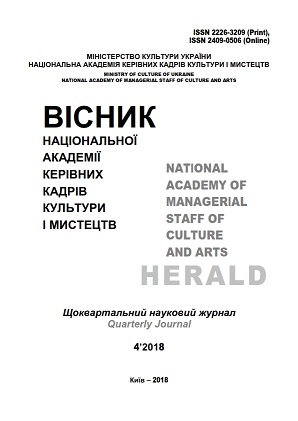Self-Regulation of Culture: The Role of Public Associations and Electronic Communication
Self-Regulation of Culture: The Role of Public Associations and Electronic Communication
Author(s): Olena Mykolayivna Goncharenko, Larysa Leonidovna NeskorodzhenaSubject(s): Civil Society, Culture and social structure , Management and complex organizations, Sociology of Culture
Published by: Національна академія керівних кадрів культури і мистецтв
Keywords: public association; self-regulation; self-regulation of culture; electronic communication; self-regulating processes; regulatory legal act;
Summary/Abstract: The purpose of the article is to study the role of public associations and modern means of electronic communication through the prism of cultural self-regulation. Methodology. The philosophical (dialectical) method was used to consider the concept of cultural self-regulation and the influence of public organizations on its formation and development; general scientific (formal-logical, method of analysis and synthesis) allowed to explore the conceptual and categorical apparatus, to determine the functions of public organizations in the field of culture; particular legal (comparative legal, formal legal) methods allowed to establish the legal basis for the activities of public associations in the area of culture, the specifics of the legal framework for electronic communication. The scientific novelty of the work lies in the implementation of a comprehensive study of the legal problems of social self-regulation in the context of the activities of public organizations and the use of modern electronic communication tools. Conclusions. The study concluded that the active work of public associations is an indicator of proper and effective management in the field of culture. It has been established that the self-regulation of culture is a complex dynamic process, which is directly carried out by the actors themselves in the field of culture without external interference. Electronic communication in the field of culture is a consequence of the creative approach to the possibility of self-regulation of processes. It was determined that public associations in the area of culture perform representative, protective functions; have the opportunity to form charitable organizations to finance cultural programs; involved in the formation of governing bodies; participate in the development of legal acts on cultural activities; represent professional artists to award state awards to creative unions and the status of creative workers; carry out certification of artists and the like. With the help of electronic communications (as a tool of self-regulation), public organizations promote the spread of culture.
Journal: Вісник Національної академії керівних кадрів культури і мистецтв
- Issue Year: 2018
- Issue No: 4
- Page Range: 121-126
- Page Count: 6
- Language: English

